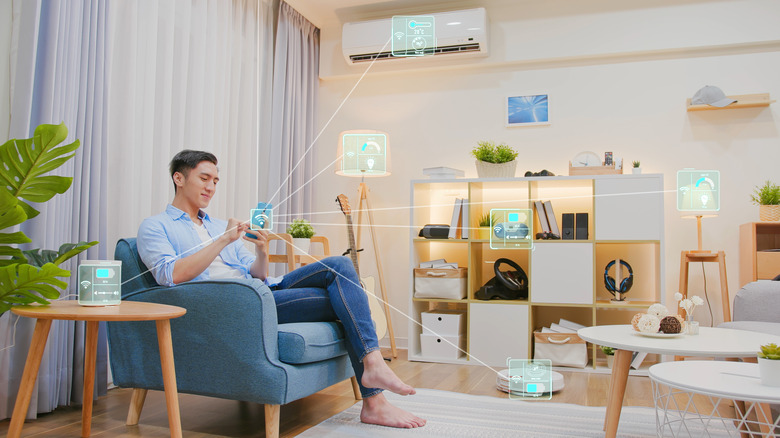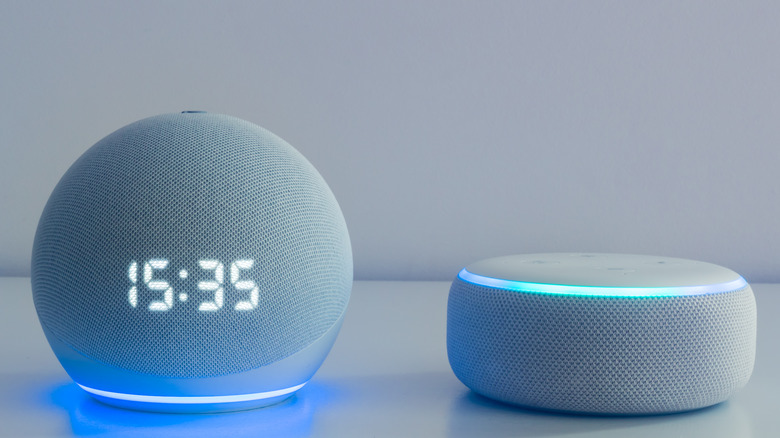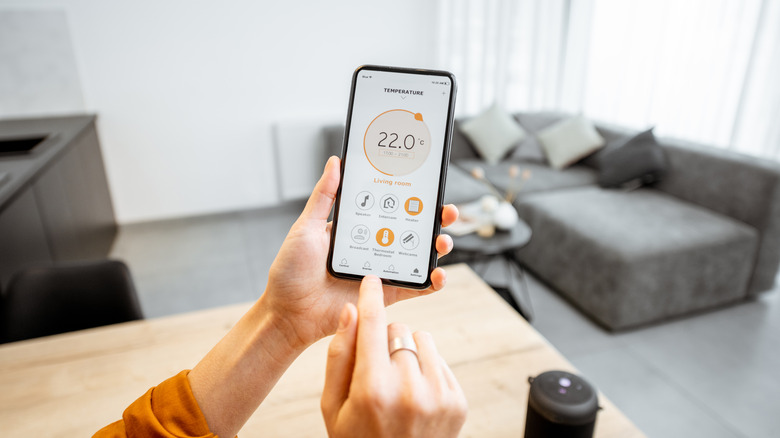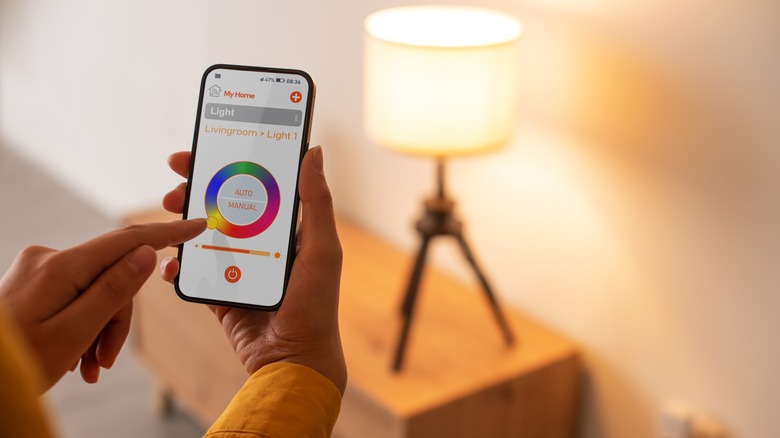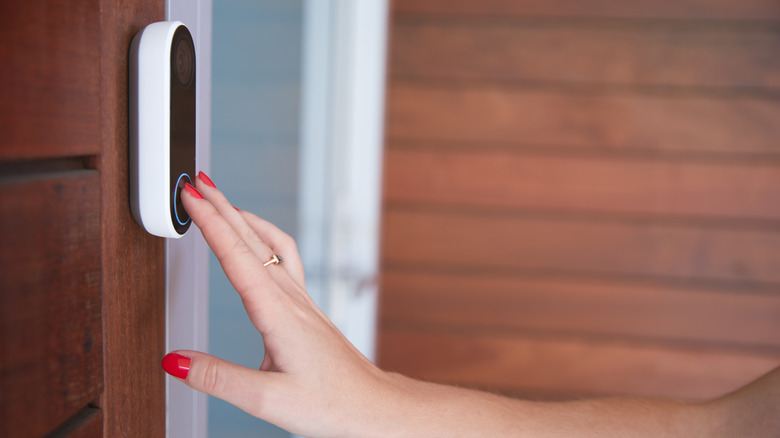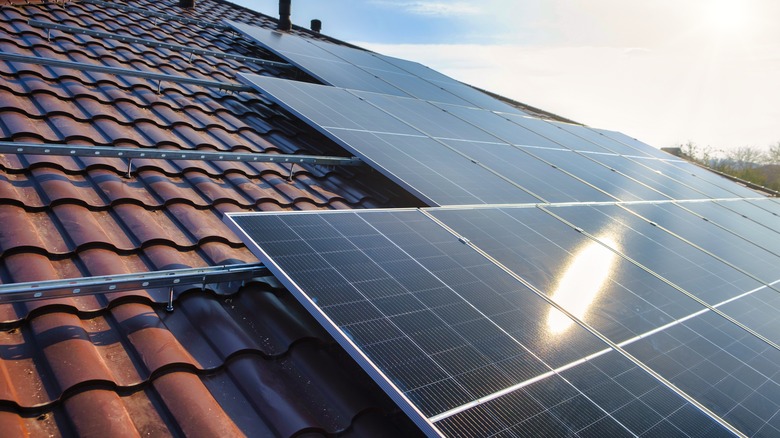How To Make Your House A Smart Home
Smart home technology assets are becoming prominent features in the modern household. A smart home is simply one that incorporates technology upgrades that make life easier (via Investopedia). From the use of an Alexa device from Amazon to heating and cooling elements that can be operated remotely, smart homes are making routine life more streamlined and everyday tasks simpler.
Smart home infrastructure can be complex or relatively scaled back — it all depends on your unique needs and circumstances. The first step to creating a smart home in your living space is to identify the kinds of changes that will make the most difference for you and your loved ones.
Not every upgrade will be useful to everyone. While some technophiles may seek out every possible customization and modernization, others may find that a single smart tool can meet all their needs. The majority of homeowners will fall somewhere in the middle of this continuum, with a few key installations making life more enjoyable and standard tasks less of a routine burden.
It's worth investigating what kinds of additions might work best in your smart home. You'll likely be surprised to find all that's on the market these days and the amazing things they can do with ease.
Consider a smart assistant device for a soft landing into this space
Smart assistant devices are growing in prevalence across American homes. Safe at Last notes that around 40 million Alexa devices have been sold in the United States, and this is only considering one type and brand of smart assistant. There's also Apple's Siri, Samsung's Bixby, and the Google Assistant, which all provide a major boost to productivity and hands-free solutions in the home and report massive sales figures respectively as well.
A smart assistant device is a voice-activated tool that can answer questions, control lighting in the home, and play music from your connected accounts. These devices have been available for many years and newer models have added screens, better speakers, and more efficient technology, all centered on providing the best possible experience to the user. Smart home installations revolve around this control center addition.
The first thing you'll need to create a smart home for your property is a smart assistant. Acting as a voice-controlled central remote, the possibilities for customization are endless with the use of one of these smart tools.
Smart switching devices can mean savings on the electricity bill
Many homes now feature smart switch controls on some of the integrated appliances and services that power the home. The water heater, for instance, can run on a consistent loop, boiling new hot water each time the overall temperature drops below a certain threshold in the tank (typically set between 120 and 140 degrees Fahrenheit, although you can raise this if you need to, up to around 180 degrees, according to HowStuffWorks).
Instead of running the heater on constant standby, you can use a smart switch to control shutoff and startup times for better energy efficiency and bill management. These types of timers have been around for a long time. Notably, pool pumps are often run on an analog timer that makes use of plastic switching pieces that are positioned according to the unit's clock spin.
Smart switches can be controlled from an app on your phone rather than a physical switch on the wall. This means that you can turn the heater off in your smart home while away on vacation, and then switch it back on as you land at the airport or come within a few hours drive of the house. Similarly, if you're running a heavy cycle of washing after returning home, you can boost the heater's runtime with ease.
Maintaining this control at the touch of your phone gives you better energy management and an intuitive tool that makes it as easy as possible.
Lighting controls can give you powerful ambiance enhancements
A smart home makes use of intelligent lighting controls. With dimming capabilities and voice activation to make the process even easier, compatible lightbulbs can make a massive difference in the quality of life and relaxation that you enjoy at home.
The ability to dim your lighting, and the added benefit of telling your smart home device to perform the function, can give your home a brand new look and feel. Many homeowners suffer from an interior space that's too bright (via Any-Lamp.com), perhaps even resembling the clinical appearance of a hospital.
This is something that you want to avoid at all costs. Health Lighting notes that warm lighting lends itself to a restful and comfortable experience while cool, whiter light is best used in spaces that are designed for energy and productive activity. As a result, bedrooms and living rooms are served best by lower-temperature, warmer light bulbs versus areas like the kitchen or a home office.
With a smart control system in place, you can further modify this color palette to create the perfect ambiance alongside a great bulb choice, enhancing the experience.
Intelligent camera arrays help with deliveries and more
Cameras have made their way into homes all across the United States. Tom's Guide lists a number of excellent security cameras for home use, noting that these installations are easy to set up and can provide a feed directly to your phone or other connected device for quick access and the best peace of mind possible.
Security cameras make a big difference in deterring criminal activity on your property. A highly visible camera is a valuable asset when it comes to preventing crimes of opportunity. But criminal deterrence isn't the only reason to install security monitoring systems throughout your smart home.
Brands have recently started producing video doorbell systems that help homeowners control access to their homes and ensure the receipt of packages and other essentials. A video doorbell provides a push notification to your phone each time someone walks up to the door, giving you the ability to ensure that the dog sitter has arrived on time, that a delivery actually makes it to your home, or that a child made it home before curfew.
Smart cameras are typically motion-activated, and with Bluetooth and Wi-Fi connectivity, have become an immensely powerful tool in the arsenal of everyday homeowners and their smart homes.
Move away from grid reliance with renewable solar additions
Solar power is another important installation that you can tackle to reinvent your home as a smart property, ready for the future. There are already nearly 3 million residential solar systems in the United States (as of 2020, according to USAFacts). These systems reduce a homeowner's reliance on the national or local grid and allow for a more self-sufficient lifestyle that benefits from better electricity bill management, greater green proactivity, and a sense of self-reliance that can't be found through many other avenues.
Adding solar panels to your home is a great way to transform your home for the better. Sun Badger Solar estimates that the return on investment for a new solar system in just the first year comes out to around 20%. Over time, the savings and boosted physical value of the property can create a swing that moves significantly in your favor.
The U.S. Green Building Council reports that tax credits on solar installation are immense as well. You can claim back 30% of the total equipment and installation costs on your federal taxes, significantly reducing the startup costs of the project once tax season rolls around.
